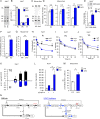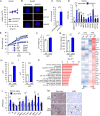LPIAT1/MBOAT7 depletion increases triglyceride synthesis fueled by high phosphatidylinositol turnover
- PMID: 32253259
- PMCID: PMC7788230
- DOI: 10.1136/gutjnl-2020-320646
LPIAT1/MBOAT7 depletion increases triglyceride synthesis fueled by high phosphatidylinositol turnover
Abstract
Objective: Non-alcoholic fatty liver disease (NAFLD) is a common prelude to cirrhosis and hepatocellular carcinoma. The genetic rs641738 C>T variant in the lysophosphatidylinositol acyltransferase 1 (LPIAT1)/membrane bound O-acyltransferase domain-containing 7, which incorporates arachidonic acid into phosphatidylinositol (PI), is associated with the entire spectrum of NAFLD. In this study, we investigated the mechanism underlying this association in mice and cultured human hepatocytes.
Design: We generated the hepatocyte-specific Lpiat1 knockout mice to investigate the function of Lpiat1 in vivo. We also depleted LPIAT1 in cultured human hepatic cells using CRISPR-Cas9 systems or siRNA. The effect of LPIAT1-depletion on liver fibrosis was examined in mice fed high fat diet and in liver spheroids. Lipid species were measured using liquid chromatography-electrospray ionisation mass spectrometry. Lipid metabolism was analysed using radiolabeled glycerol or fatty acids.
Results: The hepatocyte-specific Lpiat1 knockout mice developed hepatic steatosis spontaneously, and hepatic fibrosis on high fat diet feeding. Depletion of LPIAT1 in cultured hepatic cells and in spheroids caused triglyceride accumulation and collagen deposition. The increase in hepatocyte fat content was due to a higher triglyceride synthesis fueled by a non-canonical pathway. Indeed, reduction in the PI acyl chain remodelling caused a high PI turnover, by stimulating at the same time PI synthesis and breakdown. The degradation of PI was mediated by a phospholipase C, which produces diacylglycerol, a precursor of triglyceride.
Conclusion: We found a novel pathway fueling triglyceride synthesis in hepatocytes, by a direct metabolic flow of PI into triglycerides. Our findings provide an insight into the pathogenesis and therapeutics of NAFLD.
Keywords: fatty liver; hepatic fibrosis; lipid metabolism; lipids.
© Author(s) (or their employer(s)) 2021. Re-use permitted under CC BY. Published by BMJ.
Conflict of interest statement
Competing interests: None declared.
Figures





Similar articles
-
Mboat7 down-regulation by hyper-insulinemia induces fat accumulation in hepatocytes.EBioMedicine. 2020 Feb;52:102658. doi: 10.1016/j.ebiom.2020.102658. Epub 2020 Feb 12. EBioMedicine. 2020. PMID: 32058943 Free PMC article.
-
The MBOAT7-TMC4 Variant rs641738 Increases Risk of Nonalcoholic Fatty Liver Disease in Individuals of European Descent.Gastroenterology. 2016 May;150(5):1219-1230.e6. doi: 10.1053/j.gastro.2016.01.032. Epub 2016 Feb 2. Gastroenterology. 2016. PMID: 26850495 Free PMC article.
-
Loss of hepatic Mboat7 leads to liver fibrosis.Gut. 2021 May;70(5):940-950. doi: 10.1136/gutjnl-2020-320853. Epub 2020 Jun 26. Gut. 2021. PMID: 32591434 Free PMC article.
-
Non-Alcoholic Fatty Liver Disease.Adv Exp Med Biol. 2017;960:443-467. doi: 10.1007/978-3-319-48382-5_19. Adv Exp Med Biol. 2017. PMID: 28585211 Review.
-
MBOAT7 in liver and extrahepatic diseases.Liver Int. 2023 Nov;43(11):2351-2364. doi: 10.1111/liv.15706. Epub 2023 Aug 22. Liver Int. 2023. PMID: 37605540 Review.
Cited by
-
Modelling metabolic diseases and drug response using stem cells and organoids.Nat Rev Endocrinol. 2022 Dec;18(12):744-759. doi: 10.1038/s41574-022-00733-z. Epub 2022 Sep 7. Nat Rev Endocrinol. 2022. PMID: 36071283 Free PMC article. Review.
-
Non-Alcoholic Fatty Liver Disease: Metabolic, Genetic, Epigenetic and Environmental Risk Factors.Int J Environ Res Public Health. 2021 May 14;18(10):5227. doi: 10.3390/ijerph18105227. Int J Environ Res Public Health. 2021. PMID: 34069012 Free PMC article. Review.
-
Genetics of Metabolic Dysfunction-associated Steatotic Liver Disease: The State of the Art Update.Clin Gastroenterol Hepatol. 2024 Nov;22(11):2177-2187.e3. doi: 10.1016/j.cgh.2024.05.052. Epub 2024 Jul 31. Clin Gastroenterol Hepatol. 2024. PMID: 39094912 Review.
-
Genetic Contribution to Non-alcoholic Fatty Liver Disease and Prognostic Implications.Curr Diab Rep. 2021 Feb 5;21(3):8. doi: 10.1007/s11892-021-01377-5. Curr Diab Rep. 2021. PMID: 33544287 Free PMC article. Review.
-
Update on genetics and epigenetics in metabolic associated fatty liver disease.Ther Adv Endocrinol Metab. 2022 Oct 28;13:20420188221132138. doi: 10.1177/20420188221132138. eCollection 2022. Ther Adv Endocrinol Metab. 2022. PMID: 36325500 Free PMC article. Review.
References
Publication types
MeSH terms
Substances
LinkOut - more resources
Full Text Sources
Medical
Molecular Biology Databases
Research Materials
Miscellaneous
